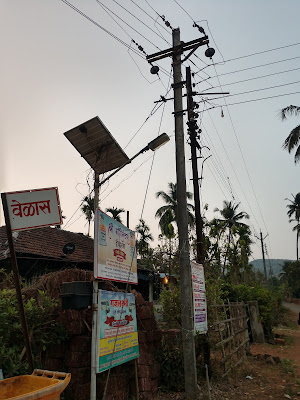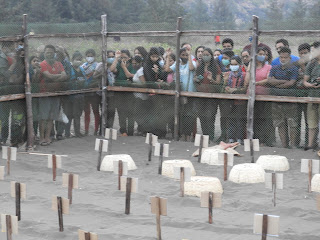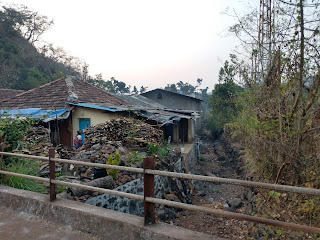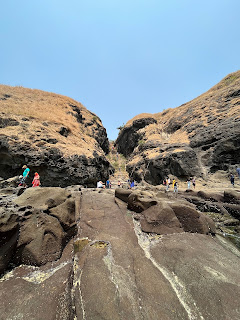Weekend
at Velas
March
11-13, 2022
This weekend, I did something I’ve never done before. I, along with 3 of my friends, decided to go exploring with an organised group. For this, our virgin experience as part of a tour group, we zeroed in on Treks & Trails (https://www.treksandtrails.org/) to take us on a weekend trip to Velas.
Velas
is a little village in the Ratnagiri district of Maharashtra, in western India.
Previously known for being the birthplace of Nana Phadnavis, a secretary in the
Peshwai of Pune, Velas is today famous for the Turtle Festival.
The festival that began in 2006 is an initiative of the Sahayadri Nisarga Mitra, a Chiploon based NGO that, together with the local villagers, works towards protecting the turtle-eggs & hatchlings from predators such as birds, lizards, accidental capture, marine pollution etc.
The
journey began with boarding an AC bus from Dadar at 10pm. The rest of the tour
members were a mixed group of largely young adults whom I found to be quite a
fun-loving, accommodating and happy bunch of people.
By
a little after 6am, we alighted at Velas beach and made our way towards the
Conservation Centre where, inside a fenced-in enclosure, we saw rows of clearly
marked nests indicating the nesting dates. Every two-hours, trained
villagers/conservationists stop by to keep a check on the eggs and hatchlings.
Once hatched, the little hatchlings are collected in a basket and taken to the
shore, to allow them the much needed run towards the sea.
When we got there, there were already a good number of people gathered around the conservation centre. By the time we moved towards the shore, more people had gathered to watch the spectacle of hatchlings making their way to the sea.
The Olive Ridley Turtle,
the second smallest of all sea turtles, gets its name from its olive coloured
carapace. Found in the tropical waters of the Pacific & Indian Oceans,
these turtles grow to weigh anywhere between 25 – 46 kgs.
Every year, the females come, in large numbers, to lay eggs on the beach. This synchronised mass nesting is known as arribadas. Interestingly, females return to the same beach where they were hatched, and lay their eggs in conical nests around 1.5ft deep. These nests are dug in the sand using their hind flippers. Although Olive Ridley Turtles are famed for arribadas, a large number of them are also known to favour solitary nesting. Most nesting beaches are only frequented by solitary nesting females with around 100 – 3000 nests.
Watching a baby turtle struggle its’ way to the water is quite an experience. Driftwood, shells and even footprints are an obstacle to these little turtles hardly over 2 inches in size. One is compelled to cheer and clap when the little fellow finally makes it into the water. It’s almost like you are one with the turtle in its struggle to survive, and its victory becomes your own.
After watching the turtles, we sat a while enjoying the sunrise and the cool morning breeze, before walking back towards the road. En route, we stopped to enjoy ukdiche modak, sweet, delicacies, freshly steamed by some local women who had set up shop close to the shore.
Then we walked back towards the village and headed to the homestay booked by the tour organisers. This turned out to be a pleasant one-storeyed home in the heart of the village, surrounded by banana and betel nut plantations. My friends & I plopped our stuff into our shared room before freshening-up and heading down to a much-needed breakfast. Our first meal of the day was served in the backyard of the house. Seated on mats spread over cow-dung paved floors, we had our fill of poha (savoury flattened rice), papad and steaming hot, sweet chai.
The
rest of the morning was spent exploring the Bankot Fort, located on a prominent and strategic point for
guarding trade along the River Savitri during Medieval times. This fort, which
finds mention in the writings of Greek geographer Ptolemy, was captured by the
Portuguese from Mohammed Adil Shah of Bijapur in 1578. Later, in 1700, it was
won by the Marathe Admiral, Kanhoji Angre. It was then taken over by the
British in 1755. They, in turn, handed it over to the Peshwas as it was not
economically viable for them to maintain the fort.
The
fort is built using Laterite rocks and has two gates. The Eastern Gate, facing
the river, is the main entrance while the Western Gate opens up to the plateau.
At the fort, we sat awhile enjoying the beautiful view of the Savitri and the surrounding hillside.
Lunch
was back at our homestay – fresh, hot rotis
(flatbread), vegetable, dal and koshimbir
(salad). A simple, home-cooked meal, but extremely wholesome &
delicious!
After
a much-needed afternoon rest my friends and I decided to skip viewing the hatchlings
and walked in the opposite direction, along the road leading away from the
village, and spent a most enjoyable evening frolicking in the waves. This
stretch of the beach is pristine and almost deserted, save for the few weekend
tourists. Although the water is temptingly cool, beware of getting stuck in the
sand.
We did not stray too far from the other revellers and had such a wonderfully relaxing time! The sunset here was also one of the best we had seen in a long time.
After dinner, we decided to take a walk through the village. It was just a little after 9 pm, but the narrow street was deserted, and the only lights were those of the street lamps and those that glowed through the windows of the villagers’ houses. There were no sounds to disturb the peace except our own voices and those of a few nocturnal insects.
Early the next morning, we took ourselves to see the rest of the village that had still not rubbed the sleep out of its eyes. Walking towards the little shrine at the entrance to the village, we took ourselves down a by-lane leading into the village. Pretty little rustic homes, a village well, monkeys swinging from the branches of the many trees and a friendly dog that followed us wherever we went. Best of all was the serenity that was all around.
Once
breakfast was done, we got back into the bus and drove towards the jetty to
board the ferry that would take us to the temple town of Harihareshwar. It is from this town that the River Savitri enters
the Arabian Sea. The temple here is believed to have been blessed by Lord
Shiva. This is why it is also known as Dakshin
Kashi. Harihareshwar is not only an important pilgrimage site, but also a popular
tourist destination, with its pristine beaches, rock caves and breath-taking
view.
For lunch, we were left to explore the neighbouring restaurants for a meal of our choice. Our cravings led us to a local home sporting two plastic tables in the shaded patio. We ordered a basic meal of freshly cooked rice, vegetable dal and fried fish.
It
was well past noon by the time we were done and headed back t the bus. The
summer sun was beating down on us relentlessly and the heat was stifling. Once
we began our journey back towards Mumbai, the air-conditioning within the
confines of the bus provided much respite.
The journey back was long, but very pleasant, with song and games played along with the other members of the tour.
When
our weekend began, I did have my reservations about travelling with an organised
tour group, but by the end of our little vacation, I found myself to be quite
happy I had been part of this trip. It wasn’t very restrictive and the people
were friendly. The overall experience was really good and I can honestly admit,
I’m more open to considering another trip, if something does catch my fancy.



























































